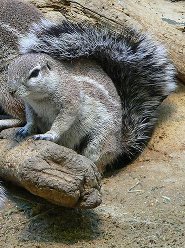 The South African Ground Squirrel (Xerus Inauris) is also known as the Cape Ground Squirrel in England. In French, it is called Écureuil foisseur de cap and in German, it is known as Kap-erdhornchen. The length of this squirrel is 28 to 38 cm (11 to 15 inches) and it weighs about 500 to 1100 gm (1.1 to 2.4 lb). The color of its coat is tawny yellow and there is a white strip on both sides of the body. There are two dark bands on its tail.
The South African Ground Squirrel (Xerus Inauris) is also known as the Cape Ground Squirrel in England. In French, it is called Écureuil foisseur de cap and in German, it is known as Kap-erdhornchen. The length of this squirrel is 28 to 38 cm (11 to 15 inches) and it weighs about 500 to 1100 gm (1.1 to 2.4 lb). The color of its coat is tawny yellow and there is a white strip on both sides of the body. There are two dark bands on its tail.The South African Ground Squirrel is mainly found in Botswana, Namibia, South Africa, and Zimbabwe. Its usual habitats are open, arid country sides with sandy areas where it digs communal burrows. The South African Ground squirrels feed on grasses, roots, shrubs, fruits, seeds, and sometimes, they feed on insects as well.
The South African Ground Squirrel does not hibernate. These squirrels are very social and live in groups with about 1 to 3 females and 2 to 3 males. Sometimes, the number of males can exceed up to 9 with some sub-adult females. An interesting thing about this breed is that mature males like to form their own groups and there can be 19 to 20 individuals in one group. These groups are called bands.
Breeding in South African Ground Squirrels is asynchronous and there is no specific period of breeding although very few litters are seen above the ground in the months of July to October. Gestation period lasts for 48 days and the young ones are weaned after 52 days. There are one to three babies per litter. A female becomes sexually mature when she is 10 months old and a male matures at the age of 8 months. Although a female has the capability to breed throughout the year, less than 10% reproduce more than one litter in a year.
As the name suggests, this species is mainly a native of South Africa, Zambezi Rivers, and southern Cunene. In Botswana, it is found in Semi-desert regions of Kalahari and also in the central parts of South Africa, the Northern Cape, and Free State. The main habitats of South African Ground Squirrels are arid parts of South Africa, Succulent Karoo, and Nama-Karoo biomes where annual rainfall is about 100 to 500 mm. These animals prefer to roam in open terrains which are covered with bushes. They are also found in floodplain areas, dry watercourses, open grasslands, or on grounds that are overgrazed. The South African Ground squirrel is a colonial, gregarious, and diurnal animal.
Picture of the South African ground squirrel by de:Benutzer:BS Thurner Hof, licensed under GNU Free Documentation License
The South african ground squirrel is listed as Least Concern. Does not qualify for a more at risk category. Widespread and abundant taxa are included in this category, on the IUCN Red List of Threatened Species
Namings for the South African ground squirrel
A young / baby of a South African ground squirrel is called a 'pup, kit or kitten'. The females are called 'doe' and males 'buck'. A South African ground squirrel group is called a 'dray or scurry'.South African ground squirrel habitats
Dry savanna, Savanna, Shrubland and Subtropical / Tropical Dry ShrublandSome facts about the
South African ground squirrel
Adult weight : 0.588 kg (1.2936 lbs)
Maximum longevity : 12 years
Female maturity :365 days
Male maturity : 365 days
Gestation : 45 days
Weaning : 50 days
Litter size : 2
Litters per year : 1
Weight at birth : 0.02 kg (0.044 lbs)
Basal metabolic rate : 2 W
Body mass : 0.529 kg (1.1638 lbs)
Temperature : 36.85 °C (98.33 °F)

Custom Search